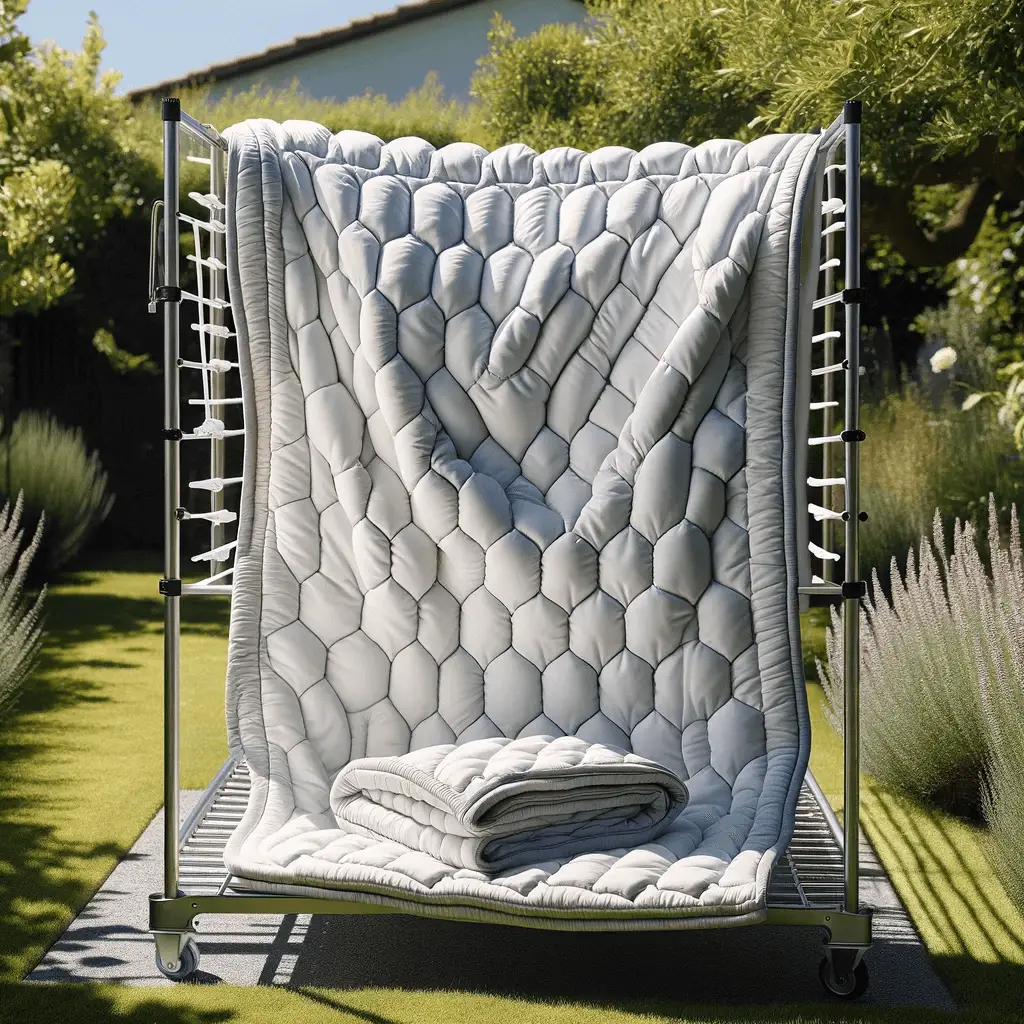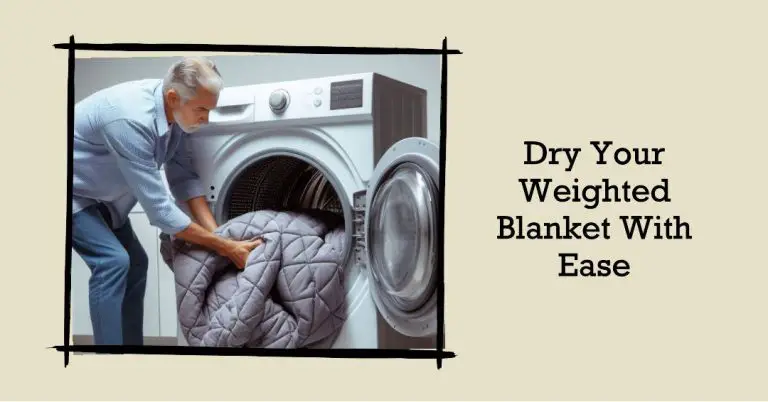Are you concerned about the proper care for your weighted blanket, especially when it comes to drying?
Weighted blankets require special attention to maintain their quality and effectiveness. Improper drying can significantly reduce their lifespan and effectiveness.
Generally, it’s advisable to air dry weighted blankets to maintain their integrity. However, some can be safely tumble dried on a low heat setting, as per the manufacturer’s care instructions. Always refer to the care label for specific guidance.
Read on to discover the best ways to dry your weighted blanket.
Table of Contents

Reading weighted blankets care labels
Proper care of a weighted blanket begins with understanding its care label. The care label is a small tag that holds essential information on how to wash and dry your blanket without damaging it.
Here’s what you need to know:
- Fabric Type: Care instructions vary depending on whether your blanket is made of cotton, minky, fleece, or other materials.
- Filling Material: The type of filling (glass beads, plastic pellets, etc.) can influence the recommended washing and drying methods.
- Washing Instructions: These will indicate whether machine washing is safe and under what conditions.
- Drying Instructions: Most importantly for our focus, this section will tell you whether the blanket can be tumble dried and at what heat setting.
For example, a label might show a tumble dry symbol with one dot, indicating low heat, or a crossed-out tumble dry symbol, suggesting air drying is preferred. Following these guidelines will help preserve the integrity, weight distribution, and lifespan of your weighted blanket.
Recommendations for drying weighted blankets
When it comes to drying weighted blankets, the process requires more attention than your regular laundry.
Here are some in-depth guidelines to ensure you are drying them properly:
- Always check the care label: The foremost step is to read and follow the care label on your weighted blanket which provides specific instructions tailored to the material and design of your blanket, ensuring its safety during the drying process.
- Opt for low heat when tumble drying: If the care label permits tumble drying, it’s crucial to use a low heat setting. High heat can damage both the fabric and the fillings, altering the blanket’s texture and weight distribution.
- Be patient with drying: Weighted blankets, due to their heavy nature, take longer to dry. Whether you are air drying or using a dryer, give it ample time. Rushing the drying process can lead to damp spots or damage to the blanket.
Air Drying: The Preferred Method
Air drying is often recommended as the safest method for drying weighted blankets.
Here’s why air drying is preferred and how to do it effectively:
- Preservation of Materials: Air drying is gentle on both the fabric and the fillers. It prevents the harsh tumbling and high heat of a dryer that can cause damage to delicate materials.
- Even Distribution of Weight: Laying the blanket flat while air drying allows the weights inside to stay evenly distributed. This ensures that the blanket maintains its intended therapeutic effect.
- Prevention of Shrinkage and Damage: Heat can cause shrinkage and weaken fabric fibers over time. Air drying eliminates these risks, keeping your blanket in its original condition.
- Economical Benefits: Air drying your weighted blanket not only preserves its quality but also saves you money. Unlike using a dryer, which consumes a significant amount of electricity, air drying has no additional costs, reducing your monthly utility bills.
- Environmental Impact: By opting to air dry, you’re also contributing to a reduced household carbon footprint. This eco-friendly choice minimizes energy consumption and environmental impact, making it a sustainable practice for your home.
Effective Air Drying Techniques:

- Choosing the Right Spot: Selecting a well-ventilated area is crucial for air drying. It’s important to avoid direct sunlight which can fade the fabric and potentially weaken the materials. A shaded, airy space ensures faster and more even drying without the risks associated with sun exposure.
- The Two-Chair Method: If you don’t have a large enough drying rack, the two-chair method is a practical alternative. Spread the blanket over two chairs placed a few feet apart. This method allows air to circulate around the blanket, promoting quicker and more uniform drying.
- Use of a Duvet Cover: Employing a duvet cover can significantly reduce direct wear and tear on your weighted blanket during the drying process. It adds an extra layer of protection and makes the drying process more manageable, especially when handling larger blankets.
- Investing in a Heavy-Duty Drying Rack: For those who frequently wash their weighted blankets, investing in a heavy-duty drying rack is a wise choice. These racks are designed to support the extra weight of a wet blanket, ensuring it stays in shape and dries evenly without sagging.
- Turn or Flip Regularly: To ensure even drying, it’s important to regularly turn or flip the blanket. This action prevents moisture from settling in one area, which can lead to damp spots or mildew formation. Regular flipping also ensures that all parts of the blanket receive adequate air exposure.
- Lay It Out Properly: When laying out the blanket for air drying, ensure it’s spread out evenly. Avoid folding or bunching up the blanket, as this can result in uneven drying and potentially damage the fillers. A flat, even layout helps maintain the shape and structure of the blanket.
When Is It Safe to Use a Dryer?
While air drying is generally the safest method for weighted blankets, there are situations where using a dryer is acceptable and safe.
You need to understand when and how to use a dryer without causing damage:
- Check the Manufacturer’s Instructions: Only proceed with tumble drying if the care label explicitly states it’s safe.
- Low Heat Setting: If tumble drying is permitted, use a low or no-heat setting. High heat can damage the fabric and fillings.
- Drying Time: Be patient with the drying process. It might take longer than usual due to the blanket’s weight and density.
- Size and Weight Considerations: Heavier and larger blankets might be better off air-dried, as they can strain your dryer and may not dry evenly.
In summary, using a dryer for your weighted blanket is sometimes possible, but it should be done cautiously and only following the specific care instructions provided by the manufacturer.
Related Articles:

